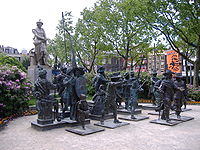
Photo from wikipedia
impinge on the literary world in such authors as Santa Teresa, Cervantes, Mateo Alemán, Sor Juana, and Benito Jerónimo Feijóo. Pueyo’s theoretical armature includes not only Foucault and Deleuze, but… Click to show full abstract
impinge on the literary world in such authors as Santa Teresa, Cervantes, Mateo Alemán, Sor Juana, and Benito Jerónimo Feijóo. Pueyo’s theoretical armature includes not only Foucault and Deleuze, but also Giorgio Agamben, although he allows theory to serve his interpretation, and not the reverse. What emerges is a serious study of the ideological formation of the self, in the form of the “cuerpo en nudo” or “knotted body,” the double body, and the folded body, for example—all of which interrogate the conditions of early capitalism and the hierarchies imposed upon the members of the political corpus. The volume is nicely produced, with fifteen black-and-white illustrations, ample bibliography, and a detailed index. It will be of interest not only to Spanish specialists, but to scholars of teratology in general. In fact, as a chapter in the rich history of the formation of the modern self, Pueyo claims to perform an “autopsy of the double body of the subject” (12). Given his argument’s resonances with debates regarding the embodied subject today, perhaps this book serves also as a societal vivisection.
Journal Title: Renaissance Quarterly
Year Published: 2017
Link to full text (if available)
Share on Social Media: Sign Up to like & get
recommendations!